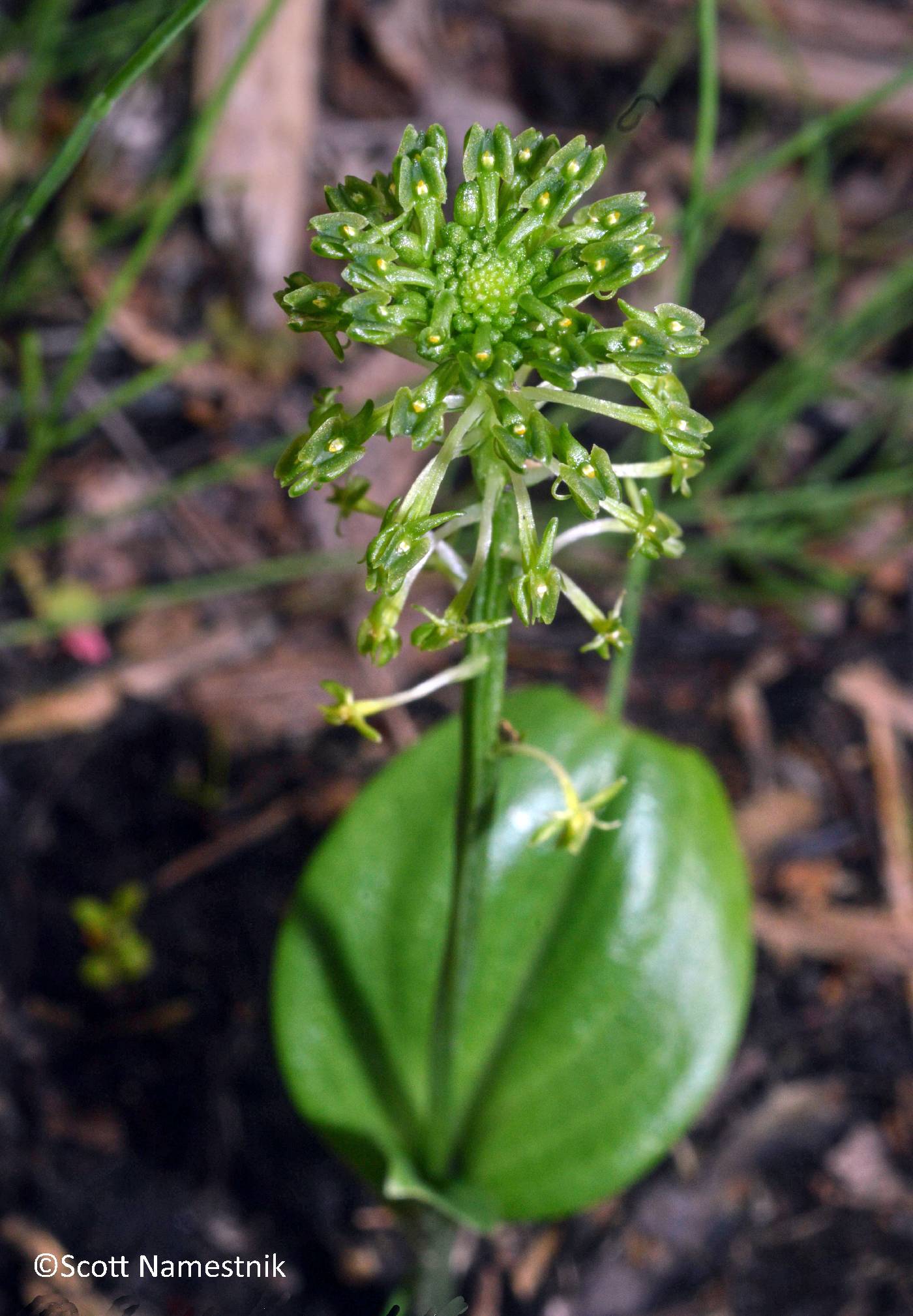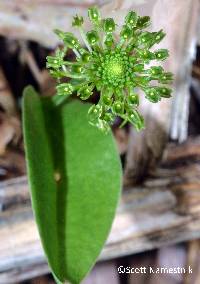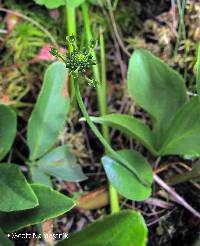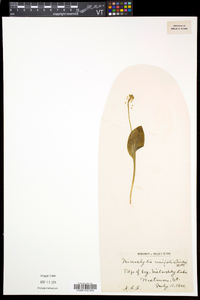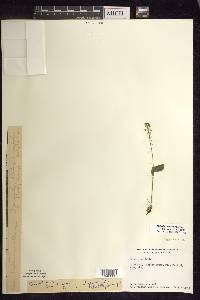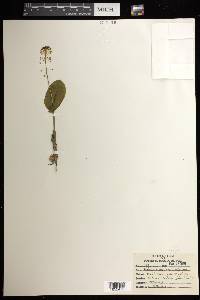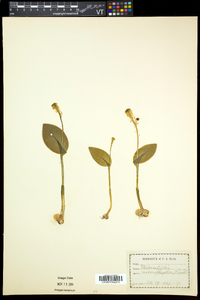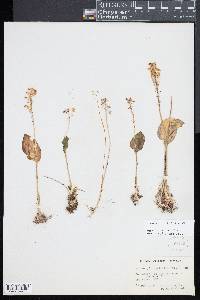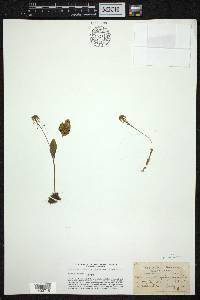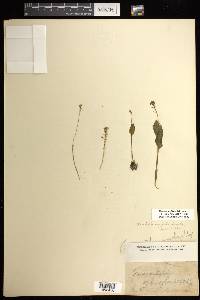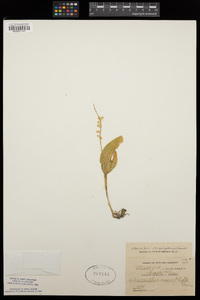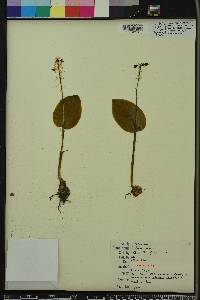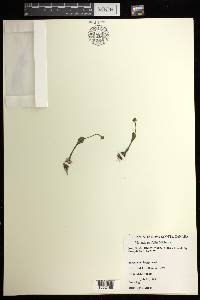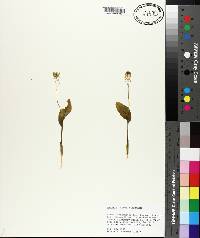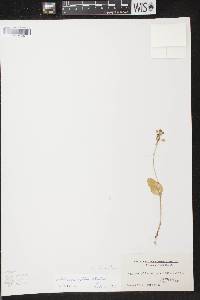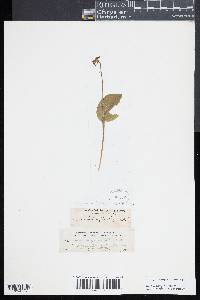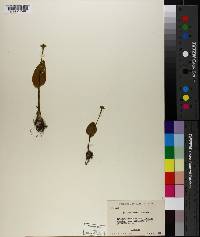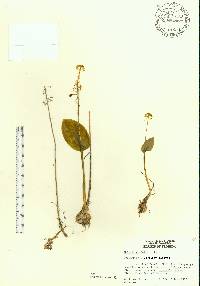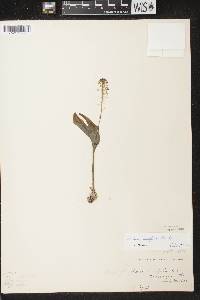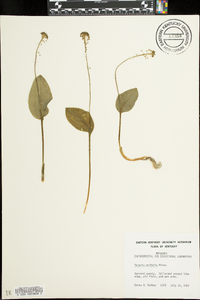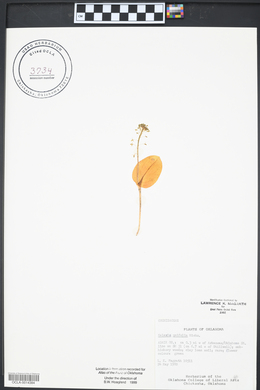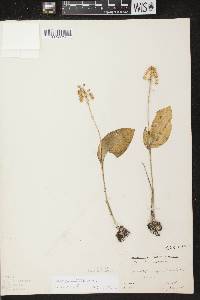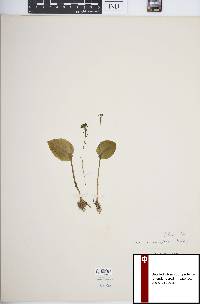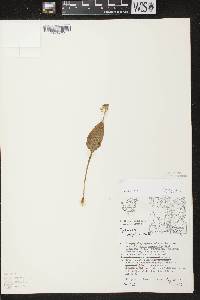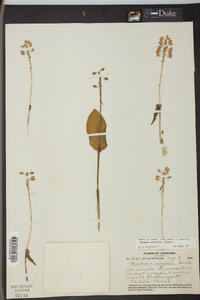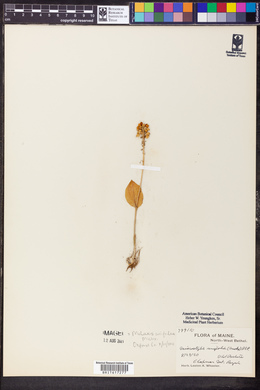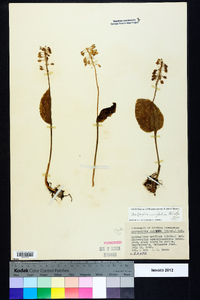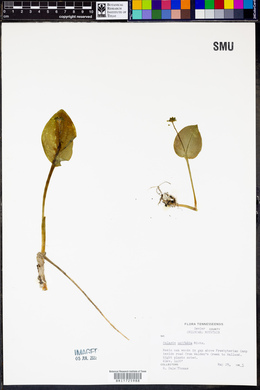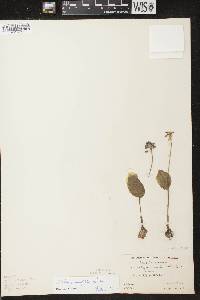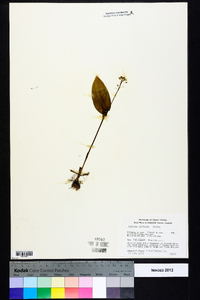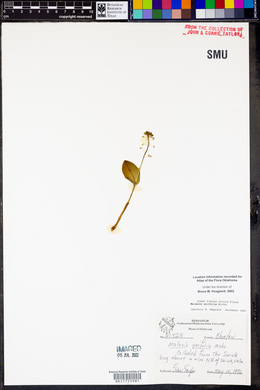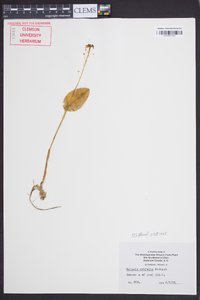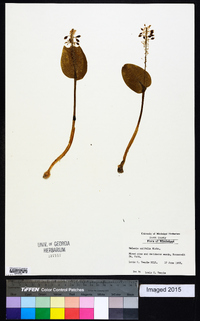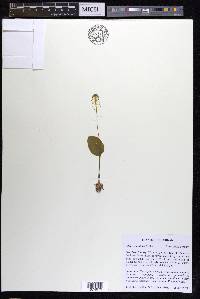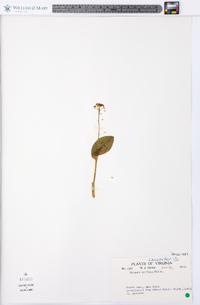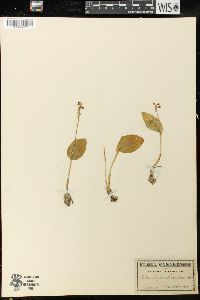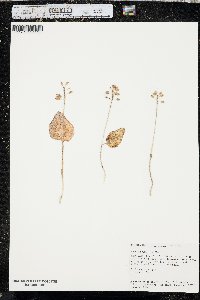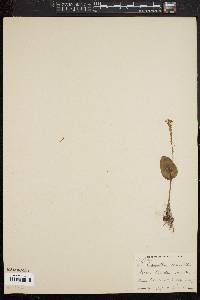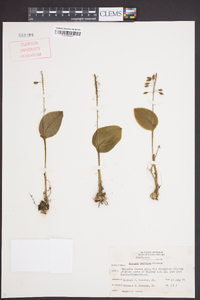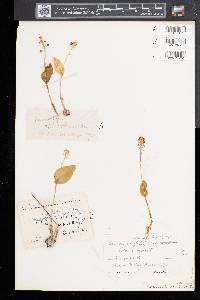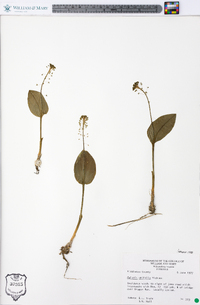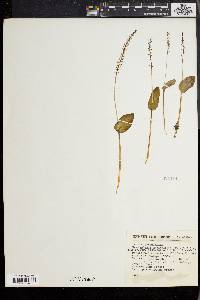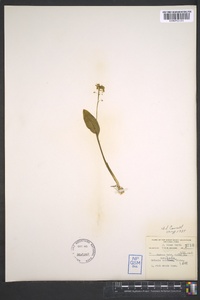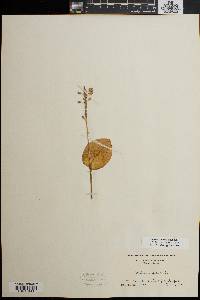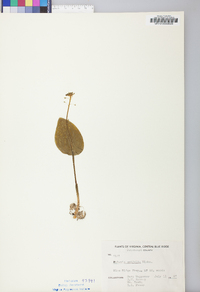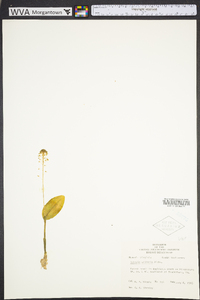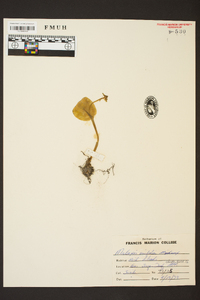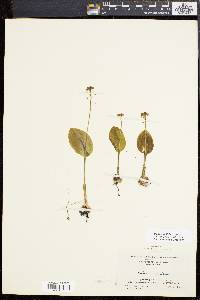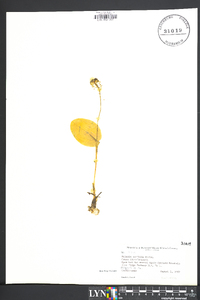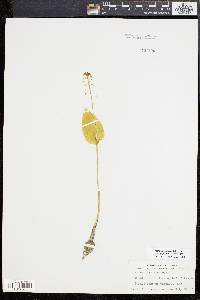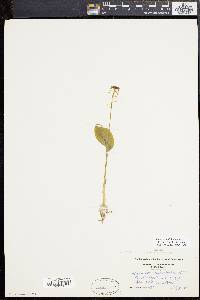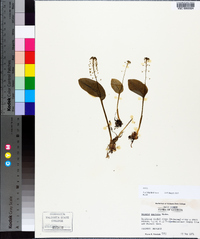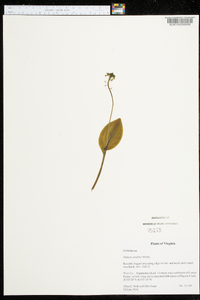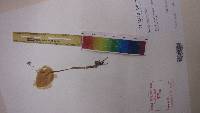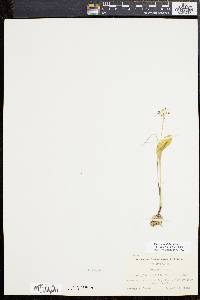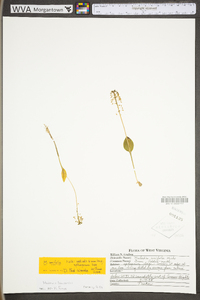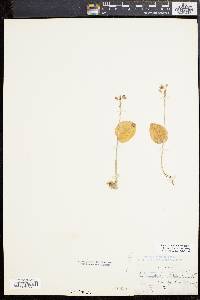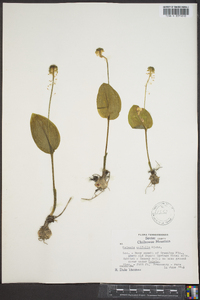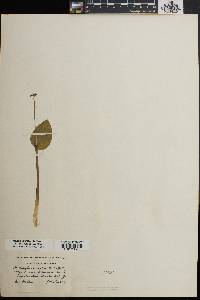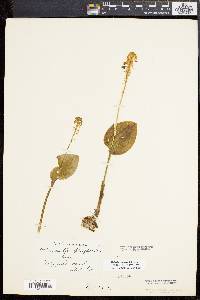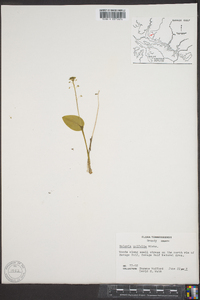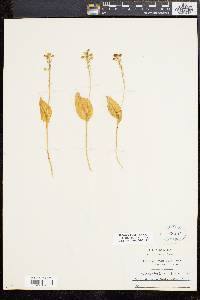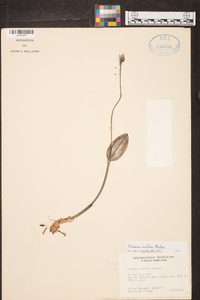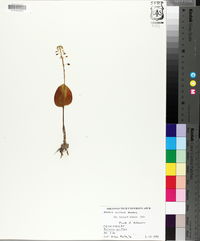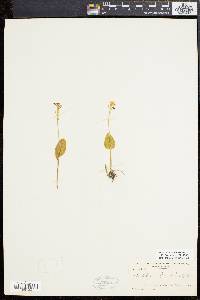Malaxis unifolia
|
|
|
|
Family: Orchidaceae
Green Adder's-Mouth Orchid
[Malaxis ophioglossoides Muhl. ex Willd., moreMicrostylis ophioglossoides , Microstylis unifolia (Michx.) Britton, Sterns & Poggenb.] |
Plants 3-50 cm. Pseudobulbs 5-20 mm diam. Leaves 1(-2, rarely), near middle of stem; blade bright green, glossy, narrowly to broadly ovate, keeled abaxially, 1.6-10 × 0.5-5 cm, apex acute. Inflorescences racemes, appearing umbellate before elongation of rachis, 1-13 cm; floral bracts triangular, 0.16-1.4 mm; pedicels (3.8-)5-10(-13) mm. Flowers 10-160, resupinate, green; dorsal sepal oblong-elliptic, 1.1-1.9 (-2.2) × 0.5-1 mm, apex acuminate; lateral sepals oblong-elliptic, 1.1-1.9(-2.2) × 0.5-1 mm, apex acuminate; petals strongly recurved, linear to filiform, slightly falcate, 0.8-1.7(-3) × 0.1-0.2(-0.3) mm; lip rhombic-deltate to cordate-ovate or oblong-elliptic, 1.1-2.3 × 1-2.2 mm, base cordate or auriculate, auricles less than 0.6 times as long as distance from base of lip to apex of middle lobe, apex 3-dentate; column 0.4-0.6 × 0.4-0.6 mm; pollinia yellow. Capsules spreading to slightly drooping, subglobose to ellipsoid, 8 × 4 mm. Flowering spring--fall (south--north). Swamps, bogs, sand barrens, heathlands, and dry woods; 0--600 m; Man., N.B., Nfld. and Labr. (Nfld.), N.S., Ont., P.E.I., Que.; Ala., Ark., Conn., Del., D.C., Fla., Ga., Ill., Ind., Iowa, Kans., Ky., La., Maine, Md., Mass., Mich., Minn., Miss., Mo., N.H., N.J., N.Y., N.C., Ohio, Okla., Pa., R.I., S.C., Tenn., Tex., Vt., Va., W.Va., Wis.; Mexico; West Indies; n Central America. Perennial herb 5 - 30 cm tall Stem: one, erect, bluish green, hairless, averaging 11 - 15 cm tall. Inflorescence: a single, erect, terminal, long-stalked, hairless, 1 - 13 cm long, elongate below and congested above, umbel-like then spike-like cluster of ten to over one hundred, stalked flowers. Each 0.4 - 1.2 cm long flower stalk is subtended by a single, tiny (0.16 - 1.4 mm long), triangular, hairless bract. Flowers: green, small, hairless, bilaterally symmetric, open (sepals spreading), with lowest petal formed into a three-lobed lip, but lacking a spur. The reproductive parts of stamens, stigma and style are fused into a short (0.4 - 0.6 mm long and wide) column above the threadlike, 0.3 - 1 cm long inferior ovary. Sepals: three, spreading, green, hairless, short (1.1 - 2.5 mm), narrow (0.5 - 1 mm), linear to oblong-elliptic with tapering pointed tips, and often rolled edges. Fruit: several, stalked, spreading to slightly drooping, hairless, ellipsoid to almost globular, 0.8 cm long, 4 mm wide capsules. Root system: of a 0.5 - 2 cm diameter oval to spherical pseudobulb often at substrate surface with fibrous true roots below. Leaf: one (rarely two), ascending, stalked, sheathing to middle of stem, bright green to bluish green (veins often darker), usually shiny, non-toothed, hairless, 1.6 - 10 cm long, 0.5 - 6 cm wide, narrow to broadly egg-shaped with pointed tip, and lengthwise ridge (keel) along lower surface. The clasping leaf stalk arises from a scalelike tubular sheath at the stem base, then sheaths the stem for at least half the stem length before abruptly flaring into the broad blade. Lateral petals: two, strongly recurved above lip, green, hairless, 0.8 - 3 mm long, 0.1 - 0.3 mm wide, linear to threadlike, and slightly hooked. Lip petal: one, central, lowermost, green, hairless, 1 - 3.5 mm long, 0.5 - 3.5 mm wide, broadly triangular to heart- or egg-shaped, but three-lobed with two lateral lobes inconspicuous, small, and ear-shaped. The conspicuous central lobe is largest, but the tip is three-toothed with a very short central tooth and much longer lateral teeth so the tip appears notched or only two-toothed. Similar species: Malaxis unifolia is most similar to M. monophyllos var. brachypoda, but that taxon has flowers in a loose elongate spike-like inflorescence, the flower stalks are shorter (under 0.5 cm), and the lip is three-lobed with the central lobe largest and egg-shaped with a distinctly pointed tip. Flowering: late June to August Habitat and ecology: Rare, in acid sterile soils, primarily sand and sphagnum in sand prairies, bogs, swampy woods, and oak barrens that flood in winter. This species has a very limited and noncontinuous distribution in the Chicago Region. Occurence in the Chicago region: native Notes: At first opening the flowers of this species are flipped so the lip petal is on top, but as the flower matures it rotates so the lip is lowermost. The inflorescence of this species appears more compact because the older, lower flower stalks elongate placing those flowers close to younger blooms and buds before the central inflorescence stalk fully elongates. Typically the inflorescence is elongate and more spread out below, and congested above. Having a more southern distribution, this species extends into Central and South America. A third species, Malaxis paludosa, occurs in the very north Great Lakes, in Canada north and east of Lake Superior. That species is distinguished from our other two by being more slender, having two to three or more leaves clustered low on the stem above the pseudobulb, the leaves are usually under 2 cm long, and the flower lip is under 2 mm long. Etymology: Malaxis is Greek for softening, in reference to the soft pliable leaves of the genus. Unifolia means one leaf, in reference to the single leaf in this species. Author: The Field Museum Scape 1-3 dm; lf solitary, sessile, oval or elliptic, 3-6 cm, a third to half as wide; infl flattened or broadly rounded at the summit; pedicels 4-8 mm; upper sep elliptic, obtuse, erect, 1.3-1.5 mm; lower sep similar, spreading or deflexed; lateral pet linear, 1 mm, recurved behind the fl; lip lowermost, greenish, oblong in general outline, 2-2.5 mm, its basal angles prolonged into auricles behind the fl, its summit deeply 2-lobed, with a small central tooth in the sinus. Damp woods and bogs; Nf. and Que. to Man., s. to Fla., Tex., W.I., and C. Amer. (Microstylis u.) Gleason, Henry A. & Cronquist, Arthur J. 1991. Manual of vascular plants of northeastern United States and adjacent Canada. lxxv + 910 pp. ©The New York Botanical Garden. All rights reserved. Used by permission. From Flora of Indiana (1940) by Charles C. Deam I have specimens from four counties: one from Vigo County from a wooded slope, one from Monroe County from "Huckleberry Hill," one from Noble County near Pleasant Lake, and one from a clump of sphagnum in the Leesburg bog, Kosciusko County. Blatchley collected a specimen at "Huckleberry Hill" in Monroe County, June 15, 1887. .…… Indiana Coefficient of Conservatism: C = 10 Wetland Indicator Status: FAC |
|
|
|

